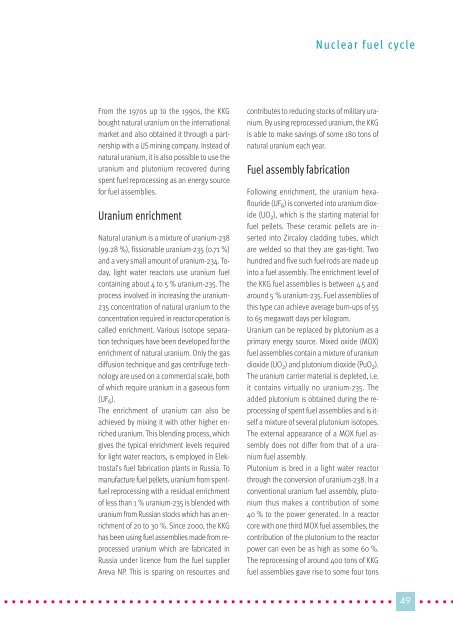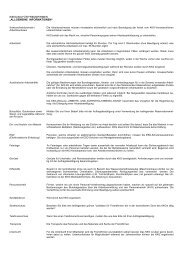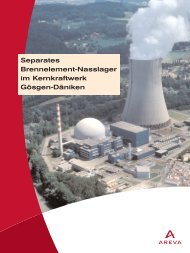Technology and Operation - Kernkraftwerk Gösgen
Technology and Operation - Kernkraftwerk Gösgen
Technology and Operation - Kernkraftwerk Gösgen
Create successful ePaper yourself
Turn your PDF publications into a flip-book with our unique Google optimized e-Paper software.
From the 1970s up to the 1990s, the KKG<br />
bought natural uranium on the international<br />
market <strong>and</strong> also obtained it through a partnership<br />
with a US mining company. Instead of<br />
natural uranium, it is also possible to use the<br />
uranium <strong>and</strong> plutonium recovered during<br />
spent fuel reprocessing as an energy source<br />
for fuel assemblies.<br />
Uranium enrichment<br />
Natural uranium is a mixture of uranium-238<br />
(99.28 %), fissionable uranium-235 (0.71 %)<br />
<strong>and</strong> a very small amount of uranium-234. Today,<br />
light water reactors use uranium fuel<br />
containing about 4 to 5 % uranium-235. The<br />
process involved in increasing the uranium-<br />
235 concentration of natural uranium to the<br />
concentration required in reactor operation is<br />
called enrichment. Various isotope separation<br />
techniques have been developed for the<br />
enrichment of natural uranium. Only the gas<br />
diffusion technique <strong>and</strong> gas centrifuge technology<br />
are used on a commercial scale, both<br />
of which require uranium in a gaseous form<br />
(UF6).<br />
The enrichment of uranium can also be<br />
achieved by mixing it with other higher enriched<br />
uranium. This blending process, which<br />
gives the typical enrichment levels required<br />
for light water reactors, is employed in Elektrostal’s<br />
fuel fabrication plants in Russia. To<br />
manufacture fuel pellets, uranium from spentfuel<br />
reprocessing with a residual enrichment<br />
of less than 1 % uranium-235 is blended with<br />
uranium from Russian stocks which has an enrichment<br />
of 20 to 30 %. Since 2000, the KKG<br />
has been using fuel assemblies made from reprocessed<br />
uranium which are fabricated in<br />
Russia under licence from the fuel supplier<br />
Areva NP. This is sparing on resources <strong>and</strong><br />
Nuclear fuel cycle<br />
contributes to reducing stocks of military uranium.<br />
By using reprocessed uranium, the KKG<br />
is able to make savings of some 180 tons of<br />
natural uranium each year.<br />
Fuel assembly fabrication<br />
Following enrichment, the uranium hexaflouride<br />
(UF6) is converted into uranium dioxide<br />
(UO2), which is the starting material for<br />
fuel pellets. These ceramic pellets are inserted<br />
into Zircaloy cladding tubes, which<br />
are welded so that they are gas-tight. Two<br />
hundred <strong>and</strong> five such fuel rods are made up<br />
into a fuel assembly. The enrichment level of<br />
the KKG fuel assemblies is between 4.5 <strong>and</strong><br />
around 5 % uranium-235. Fuel assemblies of<br />
this type can achieve average burn-ups of 55<br />
to 65 megawatt days per kilogram.<br />
Uranium can be replaced by plutonium as a<br />
primary energy source. Mixed oxide (MOX)<br />
fuel assemblies contain a mixture of uranium<br />
dioxide (UO2) <strong>and</strong> plutonium dioxide (PuO 2).<br />
The uranium carrier material is depleted, i.e.<br />
it contains virtually no uranium-235. The<br />
added plutonium is obtained during the reprocessing<br />
of spent fuel assemblies <strong>and</strong> is itself<br />
a mixture of several plutonium isotopes.<br />
The external appearance of a MOX fuel assembly<br />
does not differ from that of a uranium<br />
fuel assembly.<br />
Plutonium is bred in a light water reactor<br />
through the conversion of uranium-238. In a<br />
conventional uranium fuel assembly, plutonium<br />
thus makes a contribution of some<br />
40 % to the power generated. In a reactor<br />
core with one third MOX fuel assemblies, the<br />
contribution of the plutonium to the reactor<br />
power can even be as high as some 60 %.<br />
The reprocessing of around 400 tons of KKG<br />
fuel assemblies gave rise to some four tons<br />
� � � � � � � � � � � � � � � � � � � � � � � � � � � � � � � � � � � � � � � � � � � � � � � � � � �49 � � � � � � �




